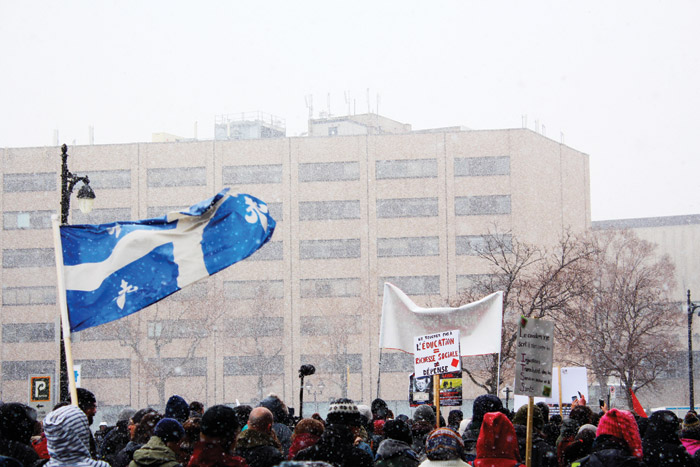On March 23, 60,000 post-secondary students went on strike against the Quebec’s government budgetary policies. 20,000 students voted to hold a one-day strike, while the remaining 40,000 will be on strike until April 2, when another demonstration is expected.
Although the students were associated under the Association pour une Solidarité Syndicale Étudiante (ASSÉ), one of the largest student unions in the province, ASSÉ did not call for a membership-wide strike vote. Local student unions will be able to hold independent votes on the possibility of striking for a day or an extended period of time, according to ASSÉ spokesperson Camille Godbout.
“Since March 21, we’ve [been] calling for multiplicity of actions against the ongoing austerity measures,” Godbout said.
Godbout continued to explain that she sees the initial mobilization efforts as the beginning of a new movement.
“My perception is that students are angry at the negative effects of austerity measures,” Godbout said. “The Couillard government [has] cut more than $200 million [from] universities’ budgets. It directly affects students in multiple ways, [through] the reduction of the number of courses offered and […] services, such as psychological support provided to students.”
At McGill, a number of individual departments and faculties have voted to go on strike. The Faculty of Medicine voted for a one-day symbolic strike, while the Department of French Literature voted to strike for a week. Other departments and faculties, including Law, Women’s Studies, and English will hold votes next week.
Students’ Society of McGill University (SSMU) Vice-President (VP) External Amina Moustaqim-Barrette clarified the procedure required for SSMU to go on strike.
“Any member of [SSMU] can bring a strike vote to the General Assembly or call a special General Assembly for a strike vote,” she said.
Moustaqim-Barrette added that SSMU remains committed to take actions against austerity following a motion passed at its Fall General Assembly, and expanded upon her portfolio’s role.
“I have been acting as a resource person for students looking to get more information or else looking to bring a strike motion to their own departments, faculties, or to SSMU,” she said. “Most of that resource provision is done through a website which provides information and resources on how to get involved, as well as things like strike kits and demonstration buddies for students looking to take action against austerity.”
Vincent Fournier Gosselin, secretary-general of the Fédération des Associations Étudiantes du campus de l’Université de Montréal (FAÉCUM), a student union at the Université de Montréal, explained that about 14,000 students at the Université de Montréal were on strike last week.
Gosselin added that some associations decided to go on strike for a day, whereas others will do so for an extended period of time.
“Our federation is composed of 83 associations,” he said. “It is the responsibility of their respective general assemblies to decide to go on strike or not.”
Benoit Lacoursière, author of The Quebec Student Movement 1983-2006, explained that he believed that this year’s protests will be different from the 2012 Maple Spring protests, where students mobilized against Jean Charest’s Liberal government’s plan to increase tuition.
“The current strikes try to appeal to a more general sense of citizenship rather than a specific issue such as the tuition fees, as was the case three years ago,” Lacoursière said. “[Students also] seem more prepared and their actions less improvised [….] They are more vocal through social media, but their presence on campuses remain minimal.”
Lacoursière continued to state that students may have difficulties mobilizing this year. He underscored the effects of the Summit of Education, which was held by Pauline Marois’ Parti Québécois government in 2012 as a follow-up to the student protests. After the summit, Marois’ government announced that it would enact a three per cent annual increase on tuition.
“What we see right now is different attitudes [within the student movement] in conflict with each other,” he said. “There is a certain fatigue by some students who were actively involved in 2012, some others are discouraged by the results of the Summit on Education that followed, [and] some groups also radicalized themselves.”
Lacoursière explained that he was not very optimistic about the expansion of the current protests.
“At the moment, there are few signs of momentum for students,” he said. “The likeliest scenario is that we will have day strikes throughout the spring instead of a larger grassroot movement.”








